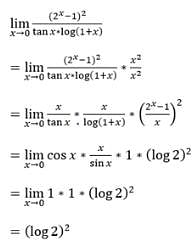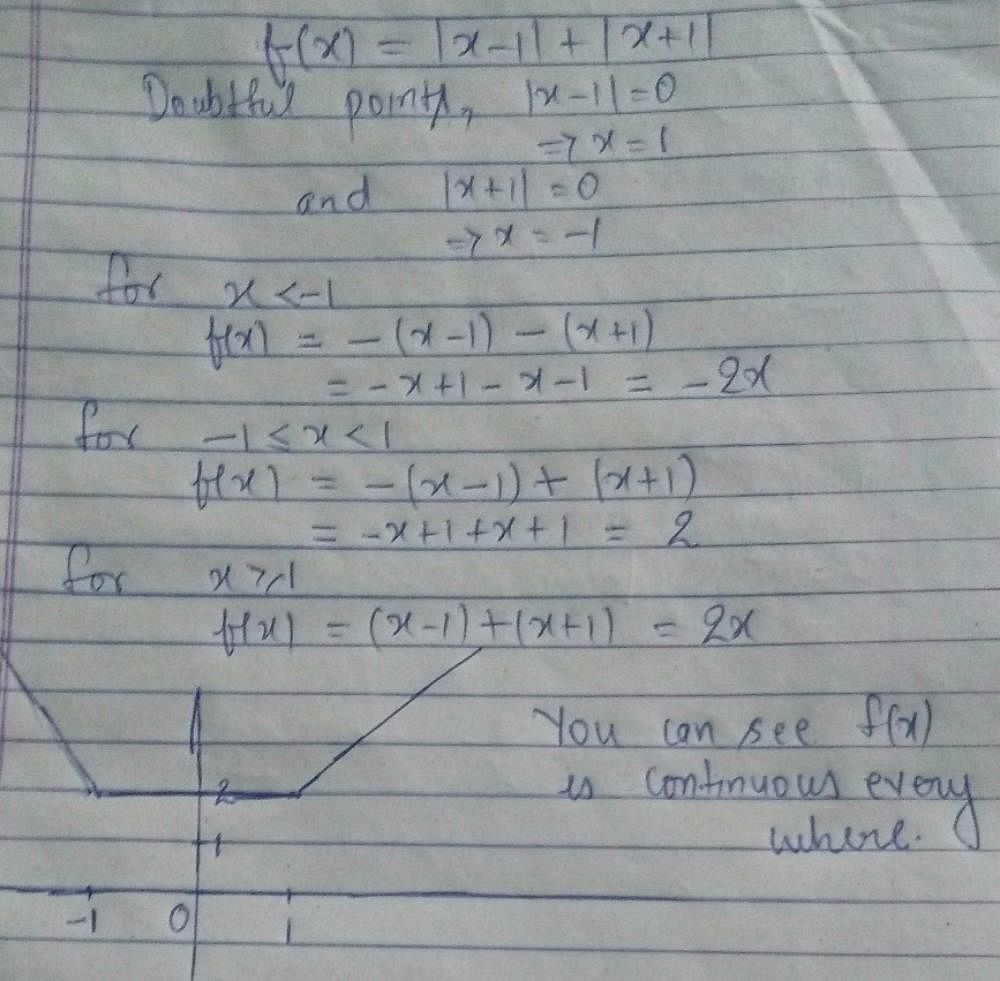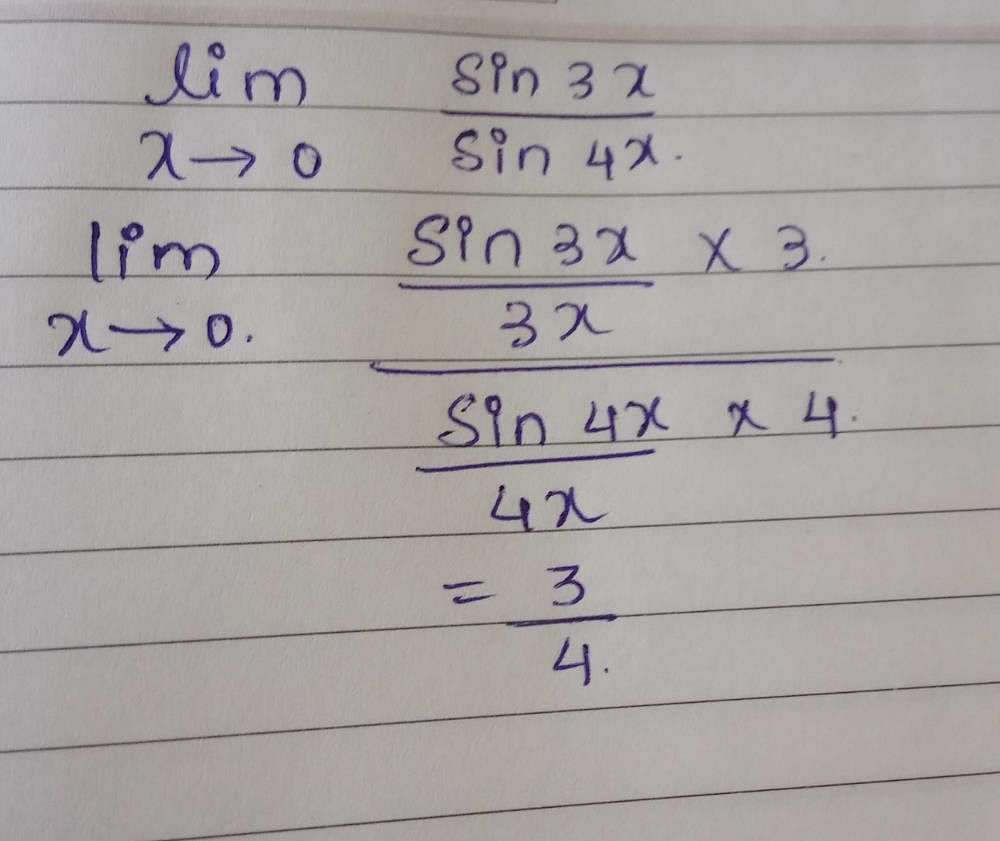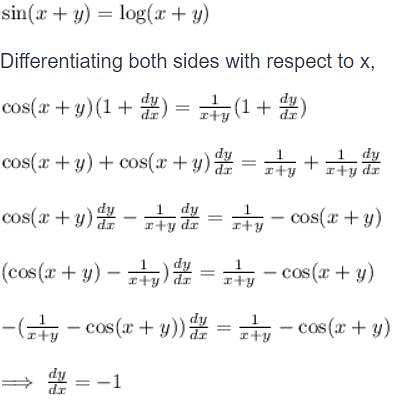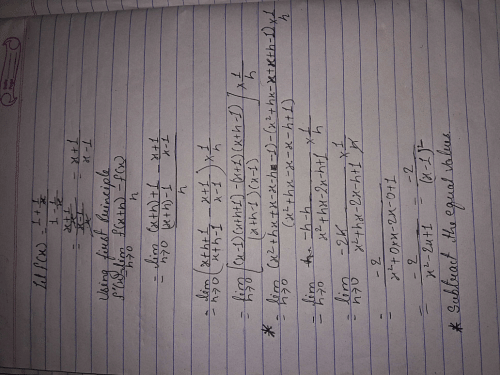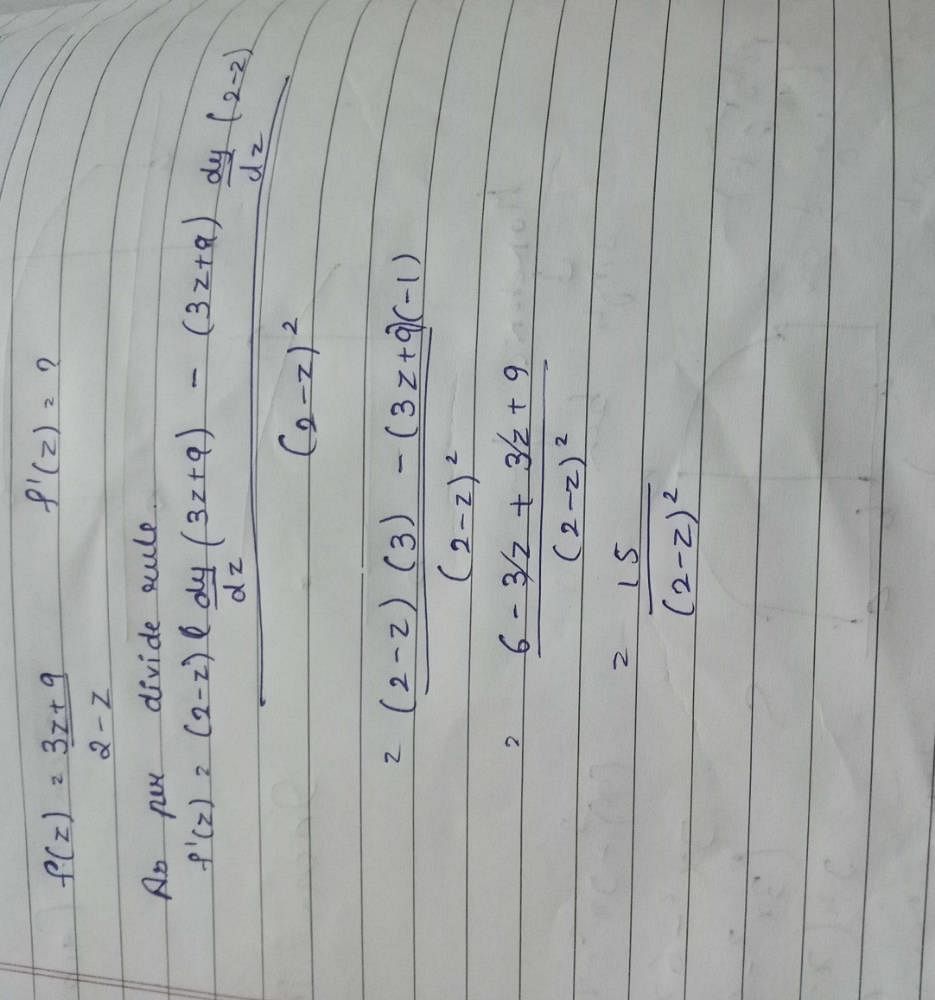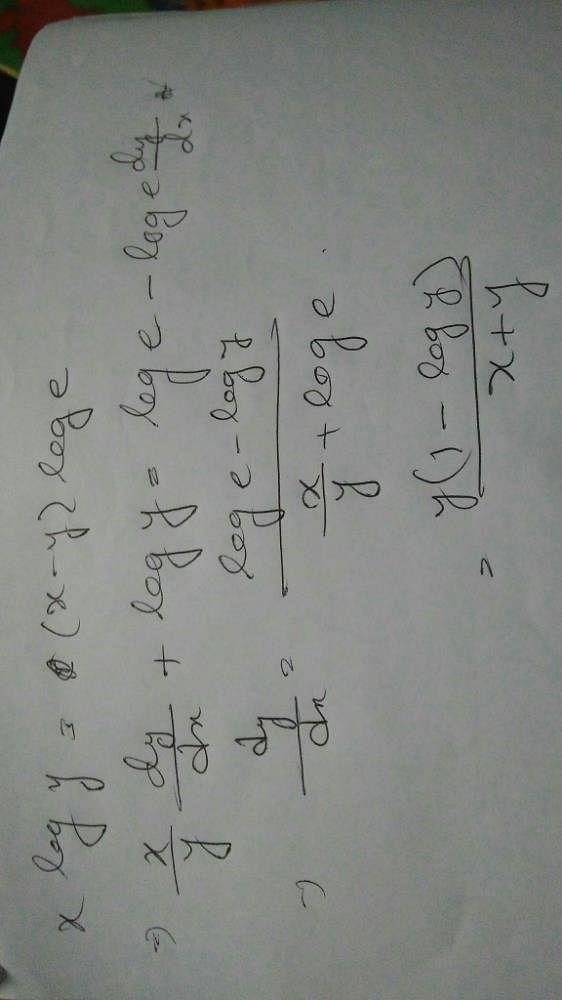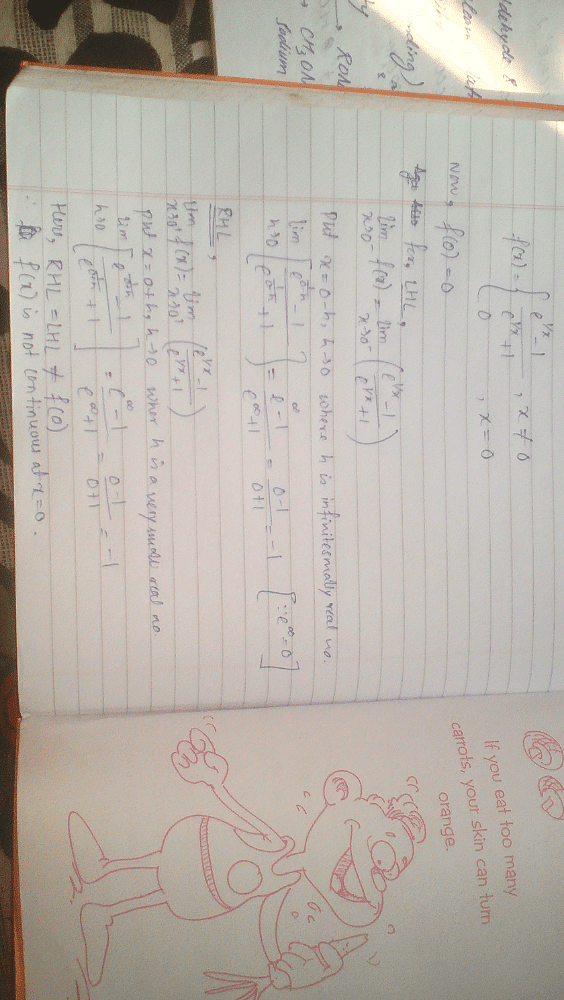All Exams >
Grade 9 >
Calculus AB >
All Questions
All questions of Unit 1: Limits and Continuity for Grade 9 Exam
| 1 Crore+ students have signed up on EduRev. Have you? Download the App |
If the function f (x) = x2– 8x + 12 satisfies the condition of Rolle’s Theorem on (2, 6), find the value of c such that f ‘(c) = 0- a)6
- b)4
- c)8
- d)2
Correct answer is option 'B'. Can you explain this answer?
If the function f (x) = x2– 8x + 12 satisfies the condition of Rolle’s Theorem on (2, 6), find the value of c such that f ‘(c) = 0
a)
6
b)
4
c)
8
d)
2
|
|
Nikita Singh answered |
f (x) = x2 - 8x + 12
Function satisfies the condition of Rolle's theorem for (2,6).
We need to find c for which f’(c) = 0
f’(x) = 2x – 8
f’(c) = 2c – 8 = 0
c = 4
Function satisfies the condition of Rolle's theorem for (2,6).
We need to find c for which f’(c) = 0
f’(x) = 2x – 8
f’(c) = 2c – 8 = 0
c = 4
When Rolle’s Theorem is verified for f(x) on [a, b] then there exists c such that- a)c ε [a, b] such that f'(c) = 0
- b)c ε (a, b) such that f'(c) = 0
- c)c ε (a, b] such that f'(c) = 0
- d)c ε [a, b) such that f'(c) = 0
Correct answer is option 'B'. Can you explain this answer?
When Rolle’s Theorem is verified for f(x) on [a, b] then there exists c such that
a)
c ε [a, b] such that f'(c) = 0
b)
c ε (a, b) such that f'(c) = 0
c)
c ε (a, b] such that f'(c) = 0
d)
c ε [a, b) such that f'(c) = 0
|
|
Arun Yadav answered |
Answer is
B) c ∈ (a, b) such that f'(c) = 0.
Statement for Rolle’s Theorem :
Suppose that a function f(x) is continuous on the closed interval [a,b] and differentiable on the open interval (a,b). Then if f(a)=f(b), then there exists at least one point c in the open interval (a,b) for which f′(c)=0.
B) c ∈ (a, b) such that f'(c) = 0.
Statement for Rolle’s Theorem :
Suppose that a function f(x) is continuous on the closed interval [a,b] and differentiable on the open interval (a,b). Then if f(a)=f(b), then there exists at least one point c in the open interval (a,b) for which f′(c)=0.

- a)

- b)

- c)

- d)

Correct answer is option 'A'. Can you explain this answer?
a)
b)
c)
d)
|
|
Lavanya Menon answered |
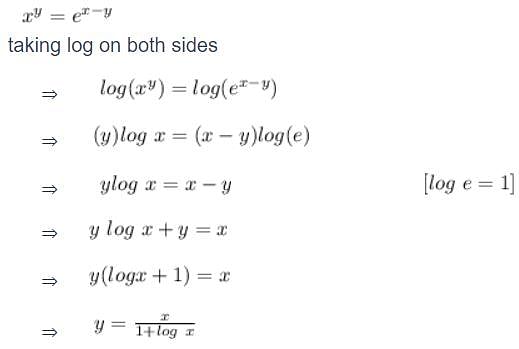
On differentiating both sides with respect to x
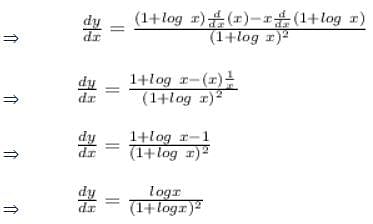
A real function f is said to be continuous if it is continuous at every point in …… .- a)[-∞,∞]
- b)The range of f
- c)The domain of f
- d)Any interval of real numbers
Correct answer is option 'A'. Can you explain this answer?
A real function f is said to be continuous if it is continuous at every point in …… .
a)
[-∞,∞]
b)
The range of f
c)
The domain of f
d)
Any interval of real numbers
|
|
Saranya Choudhury answered |
Its domain. This means that for any point x in the domain of f, as x approaches a certain value a, the value of f(x) approaches f(a). In other words, there are no sudden jumps or gaps in the graph of f.
More formally, a function f is continuous at a point a if:
1. f(a) is defined (i.e. a is in the domain of f).
2. The limit of f(x) as x approaches a exists (i.e. the left and right-hand limits are equal).
3. The limit of f(x) as x approaches a is equal to f(a).
If a function is continuous at every point in its domain, it is called a continuous function. Continuous functions have many useful properties and are often used in mathematical models and real-world applications.
More formally, a function f is continuous at a point a if:
1. f(a) is defined (i.e. a is in the domain of f).
2. The limit of f(x) as x approaches a exists (i.e. the left and right-hand limits are equal).
3. The limit of f(x) as x approaches a is equal to f(a).
If a function is continuous at every point in its domain, it is called a continuous function. Continuous functions have many useful properties and are often used in mathematical models and real-world applications.
Which of the following functions are not continuous.- a)

- b)

- c)ex
- d)

Correct answer is option 'A'. Can you explain this answer?
Which of the following functions are not continuous.
a)
b)
c)
ex
d)

|
Anu answered |
b,c,and d are continuous and [x] is discontinuous at integer points.
 For what values of a and b, f is a continuous function.
For what values of a and b, f is a continuous function.- a)a=2,b=0
- b)a=1,b=0
- c)a=0,b=2
- d)a=0,b=0
Correct answer is 'A'. Can you explain this answer?
a)
a=2,b=0
b)
a=1,b=0
c)
a=0,b=2
d)
a=0,b=0
|
|
Tejas Verma answered |
For continuity: LHL=RHL
at x=2,
LHL: x < 2 ⇒ f(x) = 2*a
RHL: x ≥ 2 ⇒ f(x) = 4
For continuity: LHL = RHL
⇒ 2a = 4 ⇒ a = 2
LHL: x < 2 ⇒ f(x) = 2*a
RHL: x ≥ 2 ⇒ f(x) = 4
For continuity: LHL = RHL
⇒ 2a = 4 ⇒ a = 2
at x = 0,
LHL: x < 0 ⇒ f(x) = b
RHL: x ≥ 0 ⇒ f(x) = 0 * a
For continuity: LHL = RHL
⇒ b = 0
LHL: x < 0 ⇒ f(x) = b
RHL: x ≥ 0 ⇒ f(x) = 0 * a
For continuity: LHL = RHL
⇒ b = 0

- a)∞
- b)e
- c)e1/3
- d)1
Correct answer is option 'C'. Can you explain this answer?
a)
∞
b)
e
c)
e1/3
d)
1
|
|
Naina Sharma answered |
lim(x → 0) (tanx/x)(1/x^2)
= (1)∞
elim(x → 0) (1/x2)(tanx/x - 1)
= elim(x → 0) ((tanx - x)/x3) .....(1)
lim(x → 0) ((tanx - x)/x3)
(0/0) form, Apply L hospital rule
lim(x → 0) [sec2x -1]/3x2
lim(x → 0) [tan2x/3x2]
= 1/3 lim(x → 0) [tan2x/x2]
= 1/3 * 1
= e1/3
= (1)∞
elim(x → 0) (1/x2)(tanx/x - 1)
= elim(x → 0) ((tanx - x)/x3) .....(1)
lim(x → 0) ((tanx - x)/x3)
(0/0) form, Apply L hospital rule
lim(x → 0) [sec2x -1]/3x2
lim(x → 0) [tan2x/3x2]
= 1/3 lim(x → 0) [tan2x/x2]
= 1/3 * 1
= e1/3
Let f be any function, such that  exists, then
exists, then 
- a)λℓ
- b)ℓ
- c)1
- d)λ
Correct answer is option 'A'. Can you explain this answer?
Let f be any function, such that  exists, then
exists, then 
a)
λℓ
b)
ℓ
c)
1
d)
λ
|
|
Om Desai answered |
lim(x → a) f(x) = l
λf(x) = λl
λf(x) = λl
Function f(x) = log x +  is continuous at
is continuous at- a)(0,1)
- b)[-1,1]
- c)(0,∞)
- d)(0,1]
Correct answer is option 'D'. Can you explain this answer?
Function f(x) = log x +  is continuous at
is continuous at
a)
(0,1)
b)
[-1,1]
c)
(0,∞)
d)
(0,1]
|
|
Om Desai answered |
- [-1,1] cannot be continuous interval because log is not defined at 0.
- The value of x cannot be greater than 1 because then the function will become complex.
- (0,1) will not be considered because its continuous at 1 as well. Hence D is the correct option.
Let (tan α) x + (sin α) y = α and (α cosec α) x + (cos α) y = 1 be two variable straight lines, α being the parameter. Let P be the point of intersection of the lines. In the limiting position when α→ 0, the coordinates of P are- a)(2 , 1)
- b) (–2 ,–1)
- c)(–2 , 1)
- d)(2 , –1)
Correct answer is option 'D'. Can you explain this answer?
Let (tan α) x + (sin α) y = α and (α cosec α) x + (cos α) y = 1 be two variable straight lines, α being the parameter. Let P be the point of intersection of the lines. In the limiting position when α→ 0, the coordinates of P are
a)
(2 , 1)
b)
(–2 ,–1)
c)
(–2 , 1)
d)
(2 , –1)

|
Maths Learner answered |
Can anyone explain the question and concept

- a)e5
- b)e4
- c)e2
- d)e3
Correct answer is option 'A'. Can you explain this answer?
a)
e5
b)
e4
c)
e2
d)
e3
|
|
Raghav Bansal answered |
lim (x → 0) [((1-3x)+5x)/(1-3x)]1/x
lim (x → 0) [1 + 5x/(1-3x)]1/x
= elim(x → 0) (1 + 5x/(1-3x) - 1) * (1/x)
= elim(x → 0) (5x/(1-3x)) * (1/x)
= elim(x → 0) (5x/(1-3x))
= e5
lim (x → 0) [1 + 5x/(1-3x)]1/x
= elim(x → 0) (1 + 5x/(1-3x) - 1) * (1/x)
= elim(x → 0) (5x/(1-3x)) * (1/x)
= elim(x → 0) (5x/(1-3x))
= e5
Examine the continuity of function 
- a)Discontinuous at x=1,2
- b)Discontinuous at x=1
- c)Continuous everywhere.
- d)Discontinuous at x=2
Correct answer is option 'C'. Can you explain this answer?
Examine the continuity of function 
a)
Discontinuous at x=1,2
b)
Discontinuous at x=1
c)
Continuous everywhere.
d)
Discontinuous at x=2
|
|
Om Desai answered |
Lim f (x) = lim (x-1)(x-2) at x tend to k
► So it get k2-3k+2
► Now f (k) = k2 -3k+2
► So f (x) =f (k) so continous at everywhere
Geometrically the Mean Value theorem ensures that there is at least one point on the curve f(x) , whose abscissa lies in (a, b) at which the tangent is- a)Parallel to the x axis
- b)Parallel to the y axis
- c)Parallel to the line joining the end points of the curve
- d)Parallel to the line y = x
Correct answer is option 'C'. Can you explain this answer?
Geometrically the Mean Value theorem ensures that there is at least one point on the curve f(x) , whose abscissa lies in (a, b) at which the tangent is
a)
Parallel to the x axis
b)
Parallel to the y axis
c)
Parallel to the line joining the end points of the curve
d)
Parallel to the line y = x

|
Ujjwal Gupta answered |
No, option C is correct answer.

- a)π – 22/7
- b)π
- c)0
- d)(7x-22)/7
Correct answer is option 'A'. Can you explain this answer?
a)
π – 22/7
b)
π
c)
0
d)
(7x-22)/7
|
|
Lavanya Menon answered |
lim(x → π ) (x - 22/7)
Taking limit, we get
⇒ π - 22/7
Taking limit, we get
⇒ π - 22/7
The derivative of 2x tan x is- a)2x log 2 [ sec2 x + tan x]
- b)2x tan x [sec x + log 2]
- c)2x [sec2 x + log 2 tan x]
- d)2x [sec2 x + tan x]
Correct answer is option 'C'. Can you explain this answer?
The derivative of 2x tan x is
a)
2x log 2 [ sec2 x + tan x]
b)
2x tan x [sec x + log 2]
c)
2x [sec2 x + log 2 tan x]
d)
2x [sec2 x + tan x]
|
|
Sarita Yadav answered |
dy/dx = 2x(tanx)' + tanx (2x)'
dy/dx = 2x (secx)2 + 2x tanx log2 , {since , (ax)' = ax loga (x)'}
dy/dx = 2x[(Secx)2 + log2 tanx]
dy/dx = 2x (secx)2 + 2x tanx log2 , {since , (ax)' = ax loga (x)'}
dy/dx = 2x[(Secx)2 + log2 tanx]
The differential coefficient of (log x)tanx is:- a)

- b)

- c)

- d)

Correct answer is option 'D'. Can you explain this answer?
The differential coefficient of (log x)tanx is:
a)
b)
c)
d)

|
Knowledge Hub answered |
y = (lnx)tanx
ln(y) = tanx(ln(lnx))
d(lny)/dx = d(tanx(ln(lnx)))/dx
Using product rule -
(1/y)dy/dx = (secx)2(ln(lnx)) + (1÷xlnx)tanx
dy/dx = [(secx)2(ln(lnx)) + (1÷xlnx)tanx ]×y
dy/dx = [(secx)2(ln(lnx)) + (1÷xlnx)tanx ]×[(lnx)tanx]
ln(y) = tanx(ln(lnx))
d(lny)/dx = d(tanx(ln(lnx)))/dx
Using product rule -
(1/y)dy/dx = (secx)2(ln(lnx)) + (1÷xlnx)tanx
dy/dx = [(secx)2(ln(lnx)) + (1÷xlnx)tanx ]×y
dy/dx = [(secx)2(ln(lnx)) + (1÷xlnx)tanx ]×[(lnx)tanx]

- a)zero
- b)1
- c)10
- d)None of these
Correct answer is option 'C'. Can you explain this answer?
a)
zero
b)
1
c)
10
d)
None of these
|
|
Riya Banerjee answered |
lim(x→0) [log10 + log1/10]/x
= [log10 + log10]/0
= 0/0 form
lim(x→0) [(1/(x+1/10) * 1]/1
lim(x→0) [(1/(0+1/10) * 1]/1
= 1/(1/10) => 10
= [log10 + log10]/0
= 0/0 form
lim(x→0) [(1/(x+1/10) * 1]/1
lim(x→0) [(1/(0+1/10) * 1]/1
= 1/(1/10) => 10
Can you explain the answer of this question below:
- A:
zero
- B:
1
- C:
10
- D:
None of these
The answer is c.
zero
1
10
None of these
|
|
Om Desai answered |
lim(x→0) [log10 + log1/10]/x
= [log10 + log10]/0
= 0/0 form
lim(x→0) [(1/(x+1/10) * 1]/1
lim(x→0) [(1/(0+1/10) * 1]/1
= 1/(1/10) => 10
= [log10 + log10]/0
= 0/0 form
lim(x→0) [(1/(x+1/10) * 1]/1
lim(x→0) [(1/(0+1/10) * 1]/1
= 1/(1/10) => 10
The value of c for which Lagrange’s theorem f(x) = |x| in the interval [-1, 1] is- a)1/2
- b)1
- c)-1/2
- d)non-existent in the interval
Correct answer is option 'D'. Can you explain this answer?
The value of c for which Lagrange’s theorem f(x) = |x| in the interval [-1, 1] is
a)
1/2
b)
1
c)
-1/2
d)
non-existent in the interval

|
Sai Kulkarni answered |
For LMVT to be valid on a function in an interval, the function should be continuous and differentiable on the interval
Here,
f(x) = |x| , Interval : [-1,1]

For h>0,
f’(0) = 1
For h<0,
f’(0) = -1
So, the LHL and RHL are unequal hence f(x) is not differentiable at x=0.
In [-1,1], there does not exist any value of c for which LMVT is valid.
Here,
f(x) = |x| , Interval : [-1,1]

For h>0,
f’(0) = 1
For h<0,
f’(0) = -1
So, the LHL and RHL are unequal hence f(x) is not differentiable at x=0.
In [-1,1], there does not exist any value of c for which LMVT is valid.
The value of 
- a)3/5
- b)3/2
- c)3/4
- d)2/5
Correct answer is option 'B'. Can you explain this answer?
The value of 

a)
3/5
b)
3/2
c)
3/4
d)
2/5
|
|
Neha Joshi answered |
After applying L'Hôpital's Rule and taking the limit as �x approaches 0, the limit of the derivatives is 3223, which confirms our initial computation of the limit
The derivate of the function 
- a)

- b)

- c)

- d)

Correct answer is option 'D'. Can you explain this answer?
The derivate of the function 
a)
b)
c)
d)
|
|
Gaurav Kumar answered |
Given, y = (sinx+cosx)/(sinx−cosx)
∴ dydx = [(sinx−cosx)(cosx−sinx)−(sinx+cosx)(cosx+sinx)]/(sinx−cosx)2
[by quotient rule]
= [(−sinx−cosx)2 − (sinx+cosx)2]/(sinx−cosx)2
− [(sinx−cosx)2 − (sinx+cosx)2]/(sinx−cosx)2
= − [(sin2x + cos2x − 2sinxcosx + sin2x + cos2x + 2sinxcosx)]/(sinx−cosx)2
= −2/(sinx−cosx)2
= -2/(sin2x + cos2x - 2sinxcosx)
= - 2/(1 - sin2x)
∴ dydx = [(sinx−cosx)(cosx−sinx)−(sinx+cosx)(cosx+sinx)]/(sinx−cosx)2
[by quotient rule]
= [(−sinx−cosx)2 − (sinx+cosx)2]/(sinx−cosx)2
− [(sinx−cosx)2 − (sinx+cosx)2]/(sinx−cosx)2
= − [(sin2x + cos2x − 2sinxcosx + sin2x + cos2x + 2sinxcosx)]/(sinx−cosx)2
= −2/(sinx−cosx)2
= -2/(sin2x + cos2x - 2sinxcosx)
= - 2/(1 - sin2x)
As x → a, f(x) → l, then l is called the……..of the function f(X) which is symbolically written as…….- a)

- b)

- c)

- d)

Correct answer is option 'C'. Can you explain this answer?
As x → a, f(x) → l, then l is called the……..of the function f(X) which is symbolically written as…….
a)
b)
c)
d)
|
|
Om Desai answered |
The number L is called the limit of function f(x) as x → a if and only if, for every ε>0 there exists δ>0
which is written as
lim (x → a) |f(x) − l|
lim (x → a) f(x) = l
which is written as
lim (x → a) |f(x) − l|
lim (x → a) f(x) = l
What is the point of discontinuity for signum function?- a)x=1
- b)x=-1
- c)x=0
- d)function is continuous on R
Correct answer is option 'C'. Can you explain this answer?
What is the point of discontinuity for signum function?
a)
x=1
b)
x=-1
c)
x=0
d)
function is continuous on R
|
|
Arun Khanna answered |
It has a jumped discontinuity which means if the function is assigned some value at the point of discontinuity it cannot be made continuous. But the function is definitely discontinuous at x=0. the sgn function is a discontinuous function (isolated/jump discontinuity).
What is/are conditions for a function to be continuous on (a,b)?- a)The function is continuous at each point of (a,b).
- b)The function is right continuous.
- c)The function is left continuous.
- d)Right continuous, left continuous, continuous at each point of (a,b).
Correct answer is option 'D'. Can you explain this answer?
What is/are conditions for a function to be continuous on (a,b)?
a)
The function is continuous at each point of (a,b).
b)
The function is right continuous.
c)
The function is left continuous.
d)
Right continuous, left continuous, continuous at each point of (a,b).
|
|
Nandini Iyer answered |
The three conditions required for a function f is said to be continuous on (a,b) if f is continuous at each point of (a,b), f is right continuous at x = a, f is left continuous at x = b.
 is the expected value of f at x = a given the values of f near x to the left of a. This value is called the……….of f at a.
is the expected value of f at x = a given the values of f near x to the left of a. This value is called the……….of f at a.- a)Limit
- b)Left Hand limit
- c)Right Hand Limit
- d)Value of function
Correct answer is option 'B'. Can you explain this answer?
 is the expected value of f at x = a given the values of f near x to the left of a. This value is called the……….of f at a.
is the expected value of f at x = a given the values of f near x to the left of a. This value is called the……….of f at a.a)
Limit
b)
Left Hand limit
c)
Right Hand Limit
d)
Value of function
|
|
Vivek answered |
The "-" sign over "a" indicates that x is approaching a from the left side or the from the negative x-axis direction. Hence, this limit is called left hand limit.
The differential coefficent 
- a)

- b)

- c)

- d)

Correct answer is option 'B'. Can you explain this answer?
The differential coefficent 
a)
b)
c)
d)
|
|
Mihir Yadav answered |
d(xy)=d(e(y⋅log(x)))
=e^(y⋅log(x))d(y⋅log(x))
=(xy)(dy⋅log(x) + y⋅d(log(x))
=(xy)
d(yx) = (yx)(log(y)dx + x/ydy).
Since d(xy) = d(yx) , and simplifying by xy = yx , we get
log(y)dx + x/ydy = log(x)dy + y/xdx.
Removing the denominators leads to:
xylog(y)dx + x2dy = xylog(x)dy + y2dx
(xylog(y) − y2)dx = (xylog(x) − x2)dy
dy/dx = (xylog(y)−y2)/(xy⋅log(x)−x2)
=e^(y⋅log(x))d(y⋅log(x))
=(xy)(dy⋅log(x) + y⋅d(log(x))
=(xy)
d(yx) = (yx)(log(y)dx + x/ydy).
Since d(xy) = d(yx) , and simplifying by xy = yx , we get
log(y)dx + x/ydy = log(x)dy + y/xdx.
Removing the denominators leads to:
xylog(y)dx + x2dy = xylog(x)dy + y2dx
(xylog(y) − y2)dx = (xylog(x) − x2)dy
dy/dx = (xylog(y)−y2)/(xy⋅log(x)−x2)
Consider the function f(x) = x + 10. Let us compute the value of the function f(x) for x very near to 5. Some of the points near and to the left of 5 and right to the 5 are given in the table.
- a)15
- b)15.0005
- c)14.9995
- d)10.5
Correct answer is option 'A'. Can you explain this answer?
Consider the function f(x) = x + 10. Let us compute the value of the function f(x) for x very near to 5. Some of the points near and to the left of 5 and right to the 5 are given in the table.
a)
15
b)
15.0005
c)
14.9995
d)
10.5

|
Vishwas Dasharathi answered |
4.9 approximately can be taken as 5,so we can take 5 as the function and the answer will be 15
If the right and left hand limits coincide, we call that common value as the limit of f(x) at x = a and denote it by- a)

- b)

- c)

- d)

Correct answer is option 'D'. Can you explain this answer?
If the right and left hand limits coincide, we call that common value as the limit of f(x) at x = a and denote it by
a)
b)
c)
d)
|
|
Gaurav Kumar answered |
If the right-hand and left-hand limits coincide, we say the common value as the limit of f(x) at x = a and denote it by limx→a f(x) = l
- If limx→a- f(x) is the expected value of f at x = a given the values of ‘f’ near x to the left of a. This value is known as the left-hand limit of ‘f’ at a.
- If limx→a+ f(x) is the expected value of f at x = a given the values of ‘f’ near x to the right of a. This value is known as the right-hand limit of f(x) at a.
Chapter doubts & questions for Unit 1: Limits and Continuity - Calculus AB 2024 is part of Grade 9 exam preparation. The chapters have been prepared according to the Grade 9 exam syllabus. The Chapter doubts & questions, notes, tests & MCQs are made for Grade 9 2024 Exam. Find important definitions, questions, notes, meanings, examples, exercises, MCQs and online tests here.
Chapter doubts & questions of Unit 1: Limits and Continuity - Calculus AB in English & Hindi are available as part of Grade 9 exam.
Download more important topics, notes, lectures and mock test series for Grade 9 Exam by signing up for free.
Calculus AB
22 videos|44 docs|34 tests
|
Signup to see your scores go up within 7 days!
Study with 1000+ FREE Docs, Videos & Tests
10M+ students study on EduRev
|
Free Exam Preparation
at your Fingertips!
Access Free Study Material - Test Series, Structured Courses, Free Videos & Study Notes and Prepare for Your Exam With Ease

 Join the 10M+ students on EduRev
Join the 10M+ students on EduRev
|

|
Forgot Password
OR
Signup to see your scores
go up within 7 days!
Access 1000+ FREE Docs, Videos and Tests
Takes less than 10 seconds to signup

 Therefore, f(x) continuous everywhere.
Therefore, f(x) continuous everywhere.